Catocala of Quebec
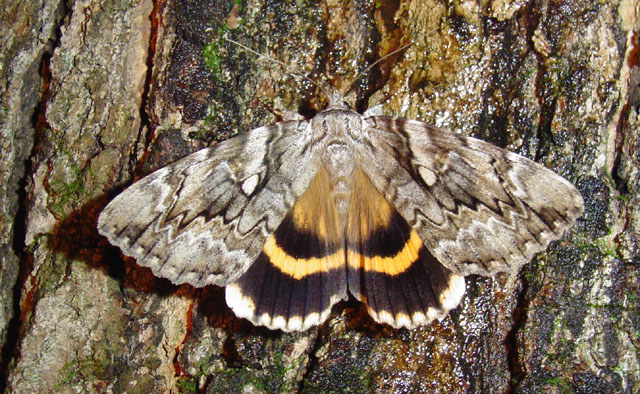

According to Louis Handfield's Le Guide des Papillons du Quebec there are thirty-nine different Catocala species found in Quebec.
The following table divides all North American Catocala species into twenty one different groups. Moths are grouped according to hindwing colour bands (yellow, orange, salmon, red, pink, black or white) and wingspan measurements (small = 30-55mm, medium = 55-75 mm and large = 75mm plus).
Wingspan refers to the distance from wing tip to wing tip when the moths are spread with the inner margin of the forewing perpendicular to the body.
Those found in Quebec are located in their respective groupings.
YELLOWnnmmmmmnmm
|
ORANGE>mmmmmm
|
SALMONmmmmmm
|
REDmmmmmmmmmm
|
mediummPINK
mmmmmmmmmmmmmm
|
BLACKmmmmmmm |
WHITEnnmmmmmm
|
Little Yellow-Orange Underwings: Wingspans: 35-45mm
similis
Little Yellow-Orange Underwings: Wingspans: 35-56mm |
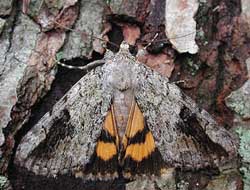
| ** 8876 Catocala micronympha, the Little Nymph Underwing, (wingspan: 35-50mm). John Himmelman image. Most specimens have grey forewings shaded with green, brown, black and white tints. Usually a darkened band passing from costa through reniform spot to o. m.. There is high variability with this species. Full size Joe Garris photo of C. micronympha form hero. |
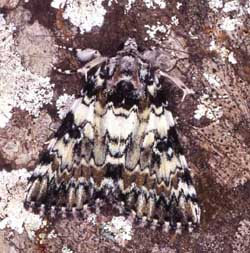
| ** 8877 connubialis, Connubial Underwing, (wingspan: 35-50mm). Fw highly variable; several different forms: "sancta" Hulst: typical form, forewings with white ground colour, sharply contrasting black lines and markings. Brown shading between post medial and subterminal lines; "cordelia" H. Edwards: coloured as above but markings faint; "pulverulenta" Brower: grey-green fws with faint markings, sometimes none; "broweri" Muller: melanic form, forewings dark green, almost black. Hw has separate anal spot and outer band ends with straight cut. Leroy Simon image. |
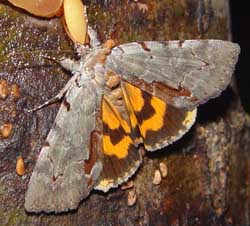
| ** 8864 Catocala grynea ; Woody Underwing, wingspan: 40-50mmThe forewing is a dull greenish grey with orangey-brown shading along the inner margin. The antemedial, median and postmedial lines are quite faint. Praeclara is somewhat similar but has a break in the brown shading between the am and pm lines. Praeclara also has a paler orange hindwing color. Tim Dyson image. |
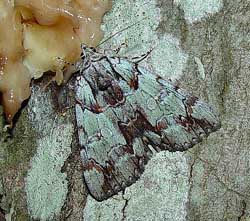
| ** 8865 praeclara; Praeclara Underwing, wingspan: 40-50mm. Fw pale greenish-grey with considerable contrasting brown shading beyond post medial line. There is a black basal dash very close to the inner margin and another dash, higher up in the median area. Note the contrasting shapes of the reniform and subreniform spots. Upper of two larger pml teeth is longer, wider than lower tooth. Note double, white filled amls. Lighter, subcircular patch, outlined in black, brown on lower thorax. |
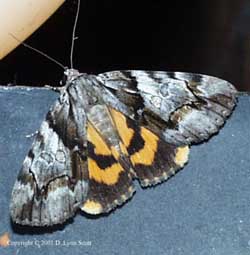
| ** 8867 Catocala blandula; Charming Underwing, wingspan: 40-50mm. Pale basal area of forewing distinguishes mira from blandula (dark brown) and crataegi (black). Fw has dark contrasting lines as in crataegi. Considerable brown in subterminal area and subreniform spot very conspicuous, usually brown. A light area runs obliquely from the costa to the subreniform spot. Hw deep orange and has a complete inner black band. The outer black band is unbroken.Lynn Scott image. |
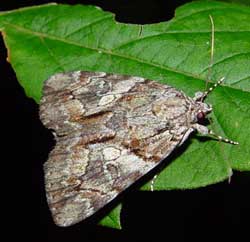
| Catocala mira; Wonderful Underwing, wingspan: 40-50mm. Pale basal area of fw distinguishes mira from blandula (dark brown) and crataegi (black). Fw lacks dark contrasting lines of crataegi and blandula. Considerable brown in subterminal area and subreniform spot very conspicuous, usually brown. Light area runs obliquely from costa to subreniform spot. Noticeable space along i. m. between antemedial and postmedial lines. Hw deep orange and has a complete inner black band. The outer black band is unbroken Tim Dyson image. |
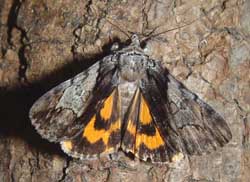
| ** 8858 Catocala crataegi WO; Hawthorn Underwing, wingspan: 40-50mm. Determination based on dark (black) shading in forewing basal area continuing along inner margin to anal angle and brown shading beyond postmedial line. Definite greenish cast to median area. The lower wing has the outer black band, broken near the anal angle, distinguishing crataegi from blandula. Tim Dyson image. |
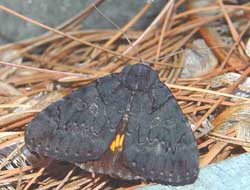
| ** 8775 antinympha;
Sweetfern Underwing, wingspan 45-55mm. |
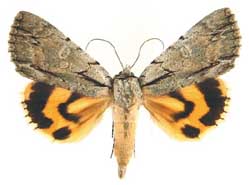
| ** 8772 clintoni; Clinton's Underwing, wingspan 45-55mm.The black basal dash distinguishes clintoni from illecta and abbreviatella, both of which lack the dash. Vernon Brou image. |
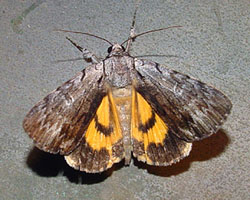
| ** 8772 gracilis; Graceful Underwing, wingspan 40-45mm.Gracilis closely resembles sordida but the hindwing loop is not complete in gracilis as it is in sordida. Gracilis also tends to have a darker inner margin and there is frequently (99% of the time, Dale Schweitzer, via Joe Garris), but not always, a basal dash. Sordida never has the basal dash. |
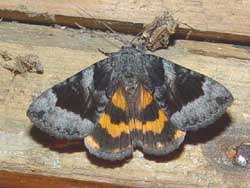
| ** 8776 coelebs; Old Maid Underwing, wingspan 54-56mm.The gray region from the forewing pm line to the outer margin readily distinguishes this species. The fringe is gray on the lower wing from the brief orange dash at the hindwing apex to the anal angle. Tim Dyson image. |
Midsized Orange-Salmon-Red-Scarlet Underwings: Wingspans: 50-72mm
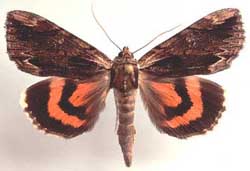
| ** 8857 Catocala ultronia; Ultronia Underwing, wingspan: 50-63mm.Fws typically gray-brown, with a distinct and very dark inner margin and characteristic light brown patch, underscored by very dark arc, near wingtip. Underwings can be yellow to orange to salmon. |
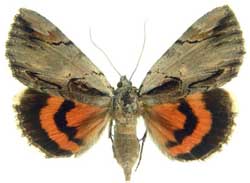
| ** 8857 Catocala ultronia form lucinda; Ultronia Underwing, wingspan: 50-63mm.In form lucinda most of the forewing is bright grey. On all forms there is
extensive orange-salmon colouration on hw ventral surface,
and there is a dark discal lunule. |
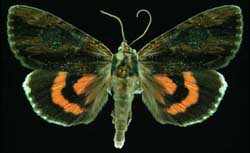
| Catocala ultronia, form nigrescens, the Ultronia Underwing, wingspan: 50-63mm. In the melanic form nigrescens, the dorsal forewing is very dark. Even darker subapical arc, basal dash and dash near anal angle are still visible. Dark basal hairs on hindwing. Harold J. Vermes slide, used with permission from his son. |
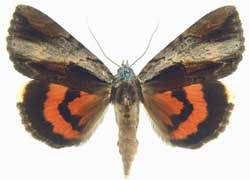
| Catocala ultronia form celia.
In form celia there is a wide, light grey band separating a dark region along inner margin and
a dark patch near the apex.
The ventral surface of forewings of all forms has a generous suffusion
of orange-salmon scales in the lower half of the median area. |
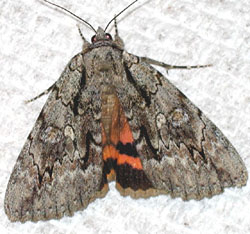
| #8778 Catocala habilis;
wingspan: 55-65mm |
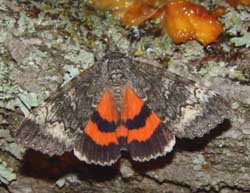
| #8817 briseis; Briseis Underwing; wingspan: 60-70mm. Fws predominantly mottled dark-grey-brown with some lighter areas 1) between postmedial and subterminal lines, 2) at very base of antemedial and postmedial lines along i. m., and 3)over subreniform spot running diagonally toward costa. Postmedial lines without greatly elongated, sharly pointed "teeth" near apex. Hw fringe white, unbroken; inner black band (fairly even) reaches i. m.. Tim Dyson image. |
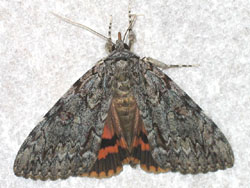
| #8795 Catocala palaeogama ; wingspan: 60-70mm. Subreniform spot closed, does not approach pm line, is smaller than in C. habilis. All forms have characteristic orange, heavily barred fringe to apex, and irregular bands on hws. Hw basal median area heavily suffused with dark brown to black scales. Dark bar in outer half of median area, paralleling i. m. halfway between i. m. and light, closed subreniform spot. Joe Garris photo. |
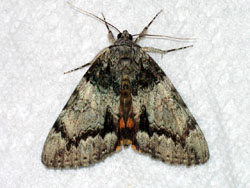
| #8795 Catocala palaeogama form phalanga; wingspan: 60-70mm. In this form, fw basal area and subterminal area are very dark against a much lighter background. Dark bar in the outer half of the median area, paralleling the inner margin halfway between the inner margin and the light, closed subreniform spot is especially evident. Joe Garris image. |
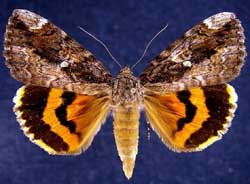
| ** 8770 Catocala innubens; Betrothed; 55-72mm. Forewing is mottled with white, grey and brown, and subrenifrom spot tends to be lighter in colour, although it is sometimes obscured by an indistinct blackish bar which runs from middle of basal/thorax connection to just below much lighter apex at outer margin.Jim Vargo image. |
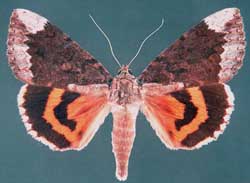
| ** 8770 Catocala innubens form scintillans; Betrothed; 55-72mm.In form scintillans most of the basal area (all but lower third) and all of the median area of the forewing is dark reddish brown. The area outside the pm line is grey. Vernon A Brou image. |
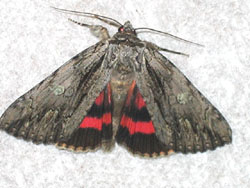
| ** 8851 Catocala coccinata; Scarlet; wingspan: 57-70mm. Usually diffuse basal, anal dashes on otherwise light grey, mottled fw. Hindwing fringe white (often with some salmon scaling), heavily checked. "Tooth" just below pair of very elongated "teeth" much reduced,s quite rounded, usually allowing considerable room for lighter patch of scales. Dark bar crosses thorax. Reniform spot light, often with greenish cast. Joe Garris image. |
Solid Black Underwings: Smallest to Largest, Similar Species Paired
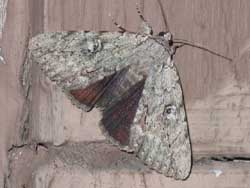
| ** 8781 judith, Judith's Underwing, (wingspan: 45-55mm), One of smaller "black" underwings.Fw uniform light grey with thin and only slightly darkened antemedial, median and postmedial lines. No darkened dashes (slight anal dash) or transverse lines. The reniform area is slightly darkened while the area just before the subterminal line is a bit lighter. Note absence of hw white fringe. Joe Garris photo. |
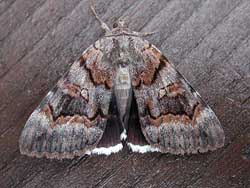
| ** 8773
Catocala epione ;
Epione Underwing, wingspan: 55-65mm. |
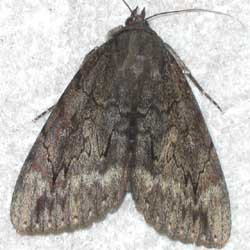
| Catocala residua, the Residua Underwing, (wingspan: 60-73mm), is distinguished from Catocala obscura by grey hindwing fringe of residua. Catocala obscura has white to off-white fringe, tends to be less common in northern portions of its range. Fw subterminal line/area of Catocala residua tends to be pale as is its open, elongated subreniform spot. Like C. obscura, otherwise devoid of significant markings except for hint of dark bar running from basal area through reniform spot to o. m. just below apex. |
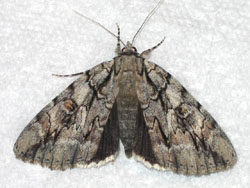
|
Catocala retecta;
wingspan: 60-75mm.
Note the light coloured, elongated and open subreniform spot
which interrupts the dark, diffuse ark running through the center of
the wing from the basal area (body-wing juncture) to the forewing
apex. The center of the reniform spot is brown and there is a brown
area just below the costa running to the inner margin just outside the pm
line. The off-white hindwing fringe is only lightly checked along the
wing veins. |
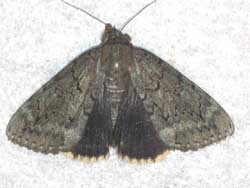
| ** 8784 obscura; the Obscure Underwing, (wingspan: 60-72mm), has dull, grey forewings, usually void of any significant dashes or streaks, providing for easy identification. The antemedial, median and postmedial lines of obscura are faint and the subterminal line region is only slightly paler than the rest of the forewing. The hindwing fringe is off-white and lightly checked on the veins. Joe Garris photo. |
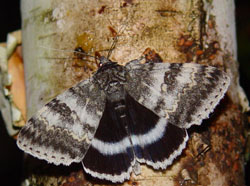
| ** 8803 Catocala relicta
;
Forsaken, White, Relict; 70-80mm:
Considerable variation with regard to black/white
concentrations on fws. |
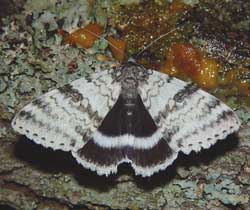
| ** 8803 Catocala relicta ; Forsaken, White, Relict; 70-80mm: Considerable variation with regard to black/white concentrations on fws. Form clara: basal and subterminal areas predominantly white.Typical specimens have basal and subterminal areas with blackish scales. Black hws, with brilliant even white inner band and white fringe, are distinctive. June until October. |
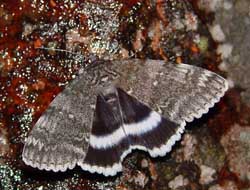
| ** 8803 Catocala relicta ; Forsaken, White, Relict; 70-80mm: Considerable variation with regard to black/white concentrations on fws. Form phrynia: evenly dusted with grey over entire forewing. Typical specimens have basal and subterminal areas with blackish scales. Black hws, with brilliant even white inner band and white fringe, are distinctive. June until October, poplars and willows |
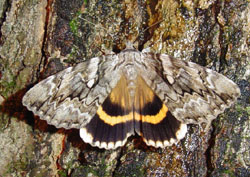
| ** 8802 Catocala cerogama; Yellow-Banded; 70-80mm. There are several different forms. The pm line is distinct, dark and has an elongate pair of projections. The pm and am lines meet the inner margin in relative proximity. The closed subreniform spot it lighter than surrounding areas, and it is shaped a bit like an arrowhead with the point toward the body. The hindwings are distinctive. Jean-Benoît Duval image. |
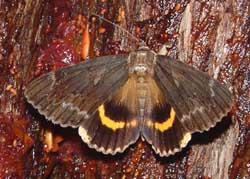
| ** 8802 Catocala cerogama; Yellow-Banded; 70-80mm.Form ruperti: Forewings are almost uniform grey-brown with white scales outlining subterminal line. The hindwings are distinctive. Tim Dyson image. |
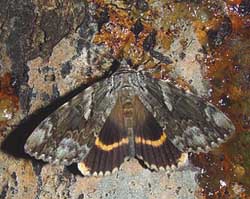
| ** 8802 Catocala cerogama; Yellow-Banded; 70-80mm.Form bunkeri: Forewings are dark in median and basal areas. Hw golden band is reduced in thickness. Basal hairs are brown instead of yellow. The hindwings are distinctive. Tim Dyson image. |
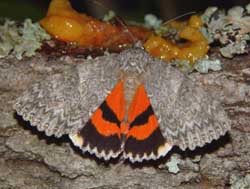
| ** 8822 meskei; Meske's Underwing; wingspan: 65-75mm. Fws less distinctly marked compared to unijuga and there is some red-orange at hw apex and just inside the fringe along the outer margin in meskei that is lacking in unijuga. Fw subreniform spot is opened or connected to the postmedian line. The hindwing postmedian band is nearly straight, turned in and tapering near the anal angle. Tim Dyson image. |
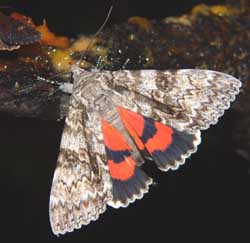
| ** 8821 semirelicta; Semirelict Underwing; wingspan: 65-75mm. Fw ground colour white with dark lines and shadings. Diffuse dark bar runs from center of basal area to o, m. a few mm above anal angle. Note regular dentation of st line. Inner black bar on the lower wing usually terminates well before the inner margin. The form "atala" has a forewing that is uniformly grey. Unijuga is usually larger and has less contrasting black lines. The inner black bar on unijuga usually reaches the inner margin. Tim Dyson image. |
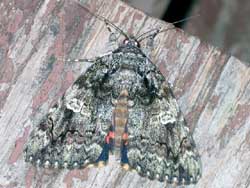
| ** 8801 Catocala ilia; Ilia; wingspan: 65-82mm. Several different forms, most have characteristic white area in and around reniform spot. Diffuse dark arc running from this spot to just below apex. Subreniform spot squarish, concave inner and outer edges and elongated constriction connecting it to pml. White dots near fw om in character with the overall "contrasting" appearance. |
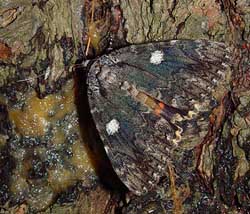
| ** 8801 Catocala ilia; Ilia; form conspicuaIn this form the entire reniform spot is heavily suffused with white scaling on an otherwise darker ground colour. Hence the form name "conspicua". Tim Dyson image. |
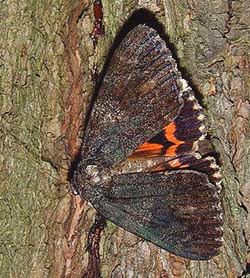
| ** 8801 Catocala ilia; Ilia; form satanasIn this melanic form the entire forewing, including the reniform spot is very dark. Hence the form name "satanas". The dark basal streak is still evident on this form. Tim Dyson image. |
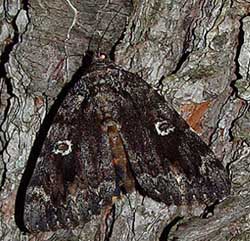
| ** 8801 Catocala ilia; Ilia; form normaniIn this semi-melanic form the entire forewing, excluding the reniform spot, is relatively dark. The brownish, kidney-shaped center of the reniform spot is outlined in white. The basal streak and subapical arc are still visible. Tim Dyson image. |
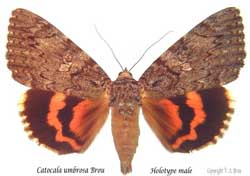
| ** 8857.1 Catocala umbrosa; mm; Double brown am line, inward line fainter, filled with off white; reniform spot brown center outlined in black , off white and black again; subreniform, large, pale brown, closed. Pm line wit htwo elongated upper teeth, next tooth reduced, next two progressively longer, rounded, final lobe rounded and shorter. HW with dark scaling/hairs in basal median area along im |
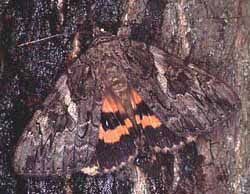
| ** 8771 Catocala piatrix ; Penitent, wingspan: 68-84mm. Fw: light-colored band/bar extending from light coloured, triangular subreniform spot along am line to costa. Brown, kidney-shaped reniform spot surrounded in pale grey, outlined in black, usually with distinct black along wing veins in a dark area outside the reniform spot. Hw: fringe lightly barred; lighter in color than deeper orange on rest of wing. |
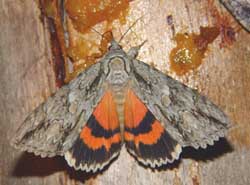
| ** 8806 Catocala parta; Mother Underwing, wingspan: 70-85mm. The black dashes in the basal, subapical and anal areas help to identify this species. The hindwings may be yellow to yellowish-orange but more often are salmon-red. Note the face-head-like markings on the thorax. In the hindwing, the first (nearest the apex) black protrusion into the white fringe is "noticeably" larger than the others. |
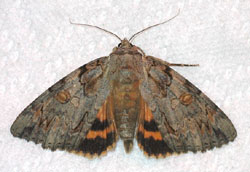
| ** 8798 Catocala neogama; wingspan 70-85mm. Brown head, thorax, larger size as compared to C. palaeogama. Neogama tend to be slightly smaller than subnata, have darker grey brown fws with more pronounced markings. Examination of hind tibia needed for id. Neogama's: flattened, unevenly, sparsely spined; subnata's: cylindrical, spines dense, uniform in distribution. Joe Garris photo. |
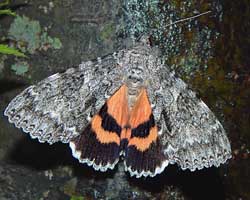
| ** 8805 unijuga; Once-married; wingspan: 70-90mm.>Catocala unijuga has a fairly wide black inner band (almost reaching inner margin) in hw and very distinctive patterning in fw. Meskei tend to have narrower band and dustier (less distinct) looking forewing. Semirelicta tend to have inner bands that terminate well before i. ms. Note very white fringe on both forewings and hindwings. Carroll Rudy image. |
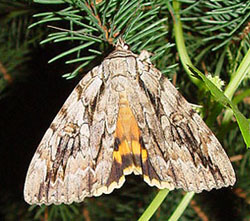
| ** 8797 Catocala subnata; Youthful Underwing, wingspan: 75-90mm. Fws greyish white with blue-grey, light brown scales. Catocala subnata usually have hws brighter yellow than those of neogama. Neogama usually have basal dash; absent in male subnata, but present in females. Magnification of hind tibia distinguish the two species: subnata: cylindrical; neogama: compressed, flattened. subnata: ventral surface of tibia densely covered with evenly distributed spines; neogama: ventral surface of tibia sparsely covered with sporadic spines. |
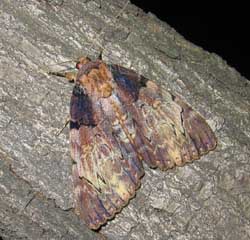
| Catocala nebulosa; Moths have prominent dark brown upper-half-basal patch that extends to and ends at antemedial line. Apical area also tends to be brown, much darker than median area but not as dark as basal patch. The anal angle also has the darker brown scaling. The pm line is distinct near costa and inner margin, but becomes weak between the two. It meets inner margin in relative close proximity to am line. Closed subreniform spot is large and connects to the pm line via a thin line. |
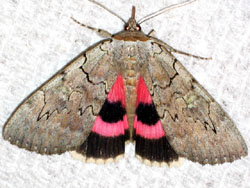
| ** 8833 concumbens Sleepy Underwing or Pink Underwing (wingspan: 60-75mm). This brown thoracic collar is quite evident in this image as is the interruption in the pm line by the open subreniform spot. The white hindwing fringe is only lightly checked on the wing veins. The vibrant pink bans are distinct in colour and also in their relatively smooth contour. |
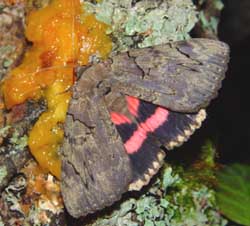
| ** 8832 Catocala cara;
Darling; wingspan 70-85mm.
Note deep maroon almost purple cast to forewings, mixed with
very pale green. Lower half of am and pm lines barely
visible. No distinctive bars, dashes. Two upper
"teeth" on the pm line are thin and long.
The hindwing bands are pink. There is heavy black checking on the
off-white hindwing fringe. The relatively thick black median band of the
hindwing almost reaches the inner margin which is usually heavily
adorned with dark hairs. |
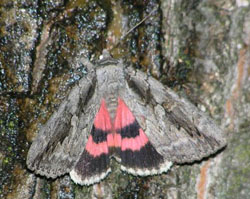
|
** 8834 amatrix Sweetheart Underwing; (wingspan 75-95mm). Very skittish, frequently hides in caves, under bridges, under tree bark, etc. by day, resting with head down. Hw patterning and colouration similar to that of C. concumbens, but large size (wingspan 75-95mm) and dark bar running from basal area to just below apex distinguishes C. amatrix. See large Catocala amatrix courtesy of Joan F. Rickert. |
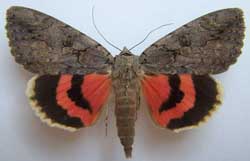
|
** 8834 amatrix form selecta
Sweetheart Underwing; (wingspan 75-95mm) |
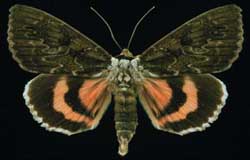
|
** 8834 amatrix form hesseli
Sweetheart Underwing; (wingspan 75-95mm) |
This page is brought to you by Bill Oehlke and the WLSS. Pages are on space rented from Bizland. If you would like to become a "Patron of the Catocala Site", contact Bill.
Please send sightings/images to Bill. I will do my best to respond to requests for identification help.
 |
Return to Canadian Index
Return to Main Index